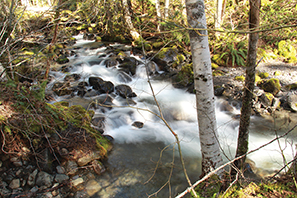 The area alongside a stream or river is referred to as a riparian zone. Plants growing along the banks are called riparian vegetation, which is primarily made up of water loving plants. Riparian zones are sometimes called buffers since they help filter pollutants out of water flowing across the landscape towards waterways. Riparian buffers areas may be natural or engineered for restoration or soil stabilization.
The area alongside a stream or river is referred to as a riparian zone. Plants growing along the banks are called riparian vegetation, which is primarily made up of water loving plants. Riparian zones are sometimes called buffers since they help filter pollutants out of water flowing across the landscape towards waterways. Riparian buffers areas may be natural or engineered for restoration or soil stabilization.
One of the most important functions of riparian vegetation is its ability to control erosion and prevent sediment pollution in the stream. Increased sediment and silt in stream water can clog fishes’ gills, bury their eggs, cover their food sources on the stream bottom, and cloud the water, shading out the sun needed for aquatic life. Vegetation on the shoreline, combined with the meandering curves of the stream or river, helps dissipate stream energy, resulting in less soil erosion and flood damage.
Shoreline and overhanging vegetation provides habitat that supports microbes, stream insects, and other food sources for fish and other aquatic life. The shading effect of vegetation also helps keep water temperatures cool, which is necessary for salmon to reproduce and thrive. Fallen trees and branches in streams can also provide pools and hiding areas for juvenile fish and other aquatic life.
Shoreline vegetation also provides a natural biofilter that helps reduce pollution in surface runoff and shallow groundwater. Plants take up nitrogen and phosphorous from fertilizers and animal waste. This helps prevent algal blooms, which consume oxygen in the water (when they naturally die off) that is essential for the health of fish and other aquatic organisms.
In many cases, clearing along our streams and waterways has come too close to our waters, which warrants an increase in the buffer width of natural vegetation. In general, studies show that buffers along ditches and streams trap eroded soils, filter pollutants such as fecal bacteria from pets and livestock, and can provide wildlife corridors. The National Marine Fisheries Service offers recommendations for buffer widths based on stream type. In general:
- For man-made ditches and streams without anadromous fish (i.e. salmon), minimum buffer widths of 35’–50’ are recommended
- For fish-bearing streams, minimum buffer widths of 100’ are recommended, and
- For fish-bearing tidal streams, minimum buffer widths of 35’–75’ are recommended.
Local regulations and site conditions vary and some sources of financial assistance for installing a vegetation buffer may include specific buffer width requirements. For more detailed guidance and assistance please contact your local Conservation District or Planning Department.